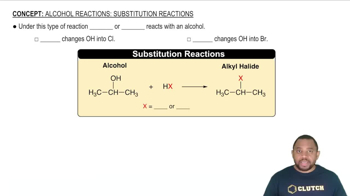Determine if each statement is true or false: (a) Substitutional alloys are solid solutions, but interstitial alloys are heterogenous alloys. (c) The atomic radii of the atoms in a substitutional alloy are similar to each other, but in an interstitial alloy, the interstitial atoms are a lot smaller than the host lattice atoms.
Ch.12 - Solids and Modern Materials
Chapter 12, Problem 44
For each of the following alloy compositions, indicate whether you would expect it to be a substitutional alloy, an interstitial alloy, or an intermetallic compound: (a) Cu₀.₆₆Zn₀.₃₄ (b) Ag₃Sn (c) Ti₀.₉₉O₀.₀₁.
 Verified step by step guidance
Verified step by step guidance1
Step 1: Understand the types of alloys. Substitutional alloys occur when atoms of the solute metal replace atoms of the solvent metal in the lattice. Interstitial alloys form when smaller atoms fit into the spaces (interstices) between the larger metal atoms. Intermetallic compounds are distinct compounds with specific stoichiometry and crystal structures.
Step 2: Analyze composition (a) Cu₀.₆₆Zn₀.₃₄. Copper and zinc are both metals with similar atomic sizes and crystal structures, which suggests that they can form a substitutional alloy, such as brass.
Step 3: Analyze composition (b) Ag₃Sn. Silver and tin form a compound with a specific stoichiometry, indicating that this is likely an intermetallic compound, characterized by a distinct crystal structure.
Step 4: Analyze composition (c) Ti₀.₉₉O₀.₀₁. Titanium is a metal, and oxygen is a non-metal. The small amount of oxygen suggests it fits into the interstices of the titanium lattice, indicating an interstitial alloy.
Step 5: Summarize the findings. Based on the analysis, (a) is a substitutional alloy, (b) is an intermetallic compound, and (c) is an interstitial alloy.
Key Concepts
Here are the essential concepts you must grasp in order to answer the question correctly.
Substitutional Alloys
Substitutional alloys are formed when atoms of one metal replace or substitute for atoms of another metal in the crystal lattice. This typically occurs when the two metals have similar atomic sizes and bonding characteristics. An example is brass, which is primarily composed of copper and zinc, where zinc atoms substitute for some copper atoms.
Recommended video:
Guided course

Alcohol Reactions: Substitution Reactions
Interstitial Alloys
Interstitial alloys are created when smaller atoms fit into the spaces (interstices) between the larger metal atoms in a crystal lattice. This type of alloy often involves a significant difference in atomic size, such as carbon in iron to form steel. The presence of smaller atoms can enhance the strength and hardness of the alloy.
Intermetallic Compounds
Intermetallic compounds are distinct phases formed between two or more metals that have a specific stoichiometric ratio and unique properties. Unlike substitutional or interstitial alloys, intermetallics often exhibit ordered structures and can have different physical and chemical properties than the constituent metals. An example is silver-tin (Ag₃Sn), which is used in dental applications.
Recommended video:
Guided course

Ionic Compounds Naming
Related Practice
Textbook Question
Textbook Question
Determine if each statement is true or false: (b) Substitutional alloys have 'solute' atoms that replace 'solvent' atoms in a lattice, but interstitial alloys have 'solute' atoms that are in between the 'solvent' atoms in a lattice.
Textbook Question
For each of the following alloy compositions, indicate whether you would expect it to be a substitutional alloy, an interstitial alloy, or an intermetallic compound: (a) Fe0.97Si0.03 (b) Fe0.60Ni0.40 (c) SmCo5.
Textbook Question
Indicate whether each statement is true or false: (c) Nonmetallic elements are never found in alloys.
